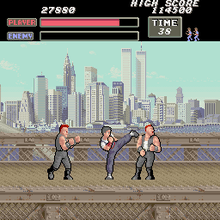Vigilante (video game)
| Vigilante | |
|---|---|
 North American arcade flyer of Vigilante. | |
| Developer(s) | Irem |
| Publisher(s) | |
| Composer(s) | Masato Ishizaki |
| Platform(s) | Arcade, Amiga, Amstrad CPC, Atari ST, Sega Master System, Commodore 64, Sega Game Gear, MSX, TurboGrafx-16, ZX Spectrum, Virtual Console |
| Release date(s) | |
| Genre(s) | Beat'em up |
| Mode(s) | Single-player |
Vigilante (ビジランテ) is a 1988 beat 'em up arcade game developed and published by Irem in Japan and Europe and published in North America by Data East. It is considered as a spiritual sequel to Irem's earlier Kung-Fu Master.
Description
Plot
The game takes place in downtown New York City. The game's plot involves a lone, professional martial artist who became a vigilante to fight an evil gang called the Skinheads ruled by a man known as the Giant Devil, in order to protect his "turf" and save his girlfriend Madonna, who was kidnapped by them.
Gameplay

Players control the titular character using punches and kicks to defeat the Skinheads in a 2D platform manner, while sometimes picking up and using nunchaku against them. If players get hurt while holding nunchuku, they become unarmed. There are five stages in order of appearance: a street, a junkyard, the Brooklyn Bridge, a back street scene and on top of a building that is under construction. Skinheads with Mohawk or spiked hairdo attack the vigilante with knives, chains, motorbikes, rifles and other kinds of weapons. They will also cling to him if he stands too close to them.
Ports and related releases
The arcade game was later ported to several different home computers and consoles. The Sega Master System version was ported and published exclusively in North America and Europe by Sega, and is one of several Sega Master System games to include an FM sound switch for enhanced music quality. In the Sega Master System version, Madonna was renamed "Maria" and the Skinheads were called the "Rogues". The ones for Commodore 64, ZX Spectrum, Atari ST, Amiga and the Amstrad CPC were reprogrammed by Emerald Software and published by U.S. Gold mostly in Europe. The MSX version was ported and published by Korean company Clover.[1] The TurboGrafx-16 version was ported and published in Japan on January 14, 1989 by Irem and published in North America by NEC the same year. This port matches the arcade more than other ports. The TurboGrafx-16 version was later re-released by Irem globally for Nintendo's Virtual Console for the Wii in North America on February 5, 2007, in Japan on February 6, 2007, in Europe on February 9, 2007, and in Australia on July 6, 2007, but was delisted on March 30, 2012 (on March 31 in Europe) before it returned in September 2013. It was also released in Japan for the Wii U Virtual Console on February 10, 2015.
References
- ↑ Clover at Generation MSX - Software Database. Date retrieved October 31, 2009.
External links
- Arcade version
- Vigilante at the Killer List of Videogames
- Vigilante at arcade-history
- Home versions